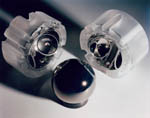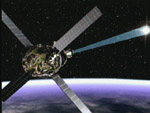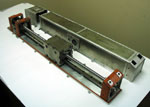WEEKLY HIGHLIGHTS FOR 25 JUNE 2004:
GRAVITY PROBE B MISSION UPDATE

On Day# 66 of the mission, the spacecraft continues to be in good health, with all subsystems performing well. The spacecraft’s orbit remains stable, ready for transition into the science phase of the mission. All four gyros remain digitally suspended, and final calibration tests at very slow gyro spin rates of up to 1 Hz (60 rpm) have been completed. The spacecraft’s roll rate has been incrementally increased from 0.3 to 0.9 rpm, as part of the process of uniformly distributing and balancing the mass of the spacecraft. Following a Flight Readiness Review currently in progress, we will begin uploading revised drag-free thruster-control software to the Attitude and Translation Control system (ATC) on-board the spacecraft over the weekend.
- This past week, we completed the last of a series of very low spin rate
calibration tests on the gyros and the gyro suspension system (GSS). As described
in previous highlights, these tests involve briefly applying voltages asymmetrically
to the suspension electrodes on a given gyro, causing that gyro rotor (sphere)
to move off center by a few millionths of a meter and then re-centering it.
We also tested the GSS by measuring the level of electrostatic charge on
each gyro rotor after applying 20% higher than normal suspension voltages
to the suspension electrodes, with the gyro rotors in spin-up position. None
of the rotors showed a significant charge build-up after this procedure,
which indicates that the GSS is functioning as anticipated.
- Additionally this past week, we continued with two procedures designed
to bring the entire spacecraft into balance, rolling smoothly about its main
axis while the telescope focuses on the guide star. In the first procedure,
called “bubble wrap,” the spacecraft’s roll rate was increased
in incremental steps, from 0.3 rpm to 0.9 rpm.
The increased roll rate begins to rotate the liquid helium, effectively pushing
it outwards as it tries to move in a straight
line with its intertia. The Dewar walls hold it in with a
centripetal force. This wraps the helium uniformly around the outer shell.
Distributing the liquid helium uniformly along the spacecraft’s roll axis helps
to ensure that the science telescope can remain locked on the guide star
while the spacecraft is rolling.
Some people might think this is centrifugal force. One might ask, what is the difference between centripetal and centrifugal force, anyway? The words centripetal and centrifugal are in fact antonyms defined as follows:
centrifugal : tending to move away from a center.
centripetal : tending to move toward a center.

- In the second procedure, called “mass trim,” weights mounted
on long screw shafts are attached in strategic locations around the spacecraft
frame. Small motors, under control of the spacecraft’s ATC, can turn
these screw shafts in either direction, causing the weights to move back
and forth by a specified amount. Thus, based on feedback from the GSS, the
spacecraft’s center of mass can be precisely centered, both forward
to back, and side to side, around the designated “drag-free gyro.”
- Finally, revisions to the spacecraft’s drag-free thruster-control software that will optimize the spacecraft’s performance, using 14 instead of 16 micro thrusters, passed a design review last week. A Flight Readiness Review is currently in progress to approve the uploading of this updated software to the spacecraft this weekend. Next week, the ATC will be re-started using the new software. The 16 micro thrusters are arranged 4 clusters, with each cluster having two pairs of thrusters. Redundancy built into the thruster system enables the spacecraft to meet the attitude control requirements for the science mission with only 12 functioning micro thrusters. In the event of a thruster problem, the original thruster-control software was designed to isolate both the malfunctioning thruster and its paired partner. The revised software now enables individual micro thrusters to be isolated in any thruster pair, without affecting the paired partner. Of the 14 micro thrusters currently functioning, only two are critically located, and if these two were both to malfunction, it is still possible to operate the thruster system by partially opening the valves in the isolated thrusters.

- Once the revised thruster-control software is up and running, the helium bubble is wrapped, and the spacecraft’s mass has been trimmed, we will lock onto the guide star, IM Pegasi, in a drag-free orbit, in preparation for the science mission.
The spacecraft is being controlled from the Gravity Probe B Mission Operations Center, located here at Stanford University. The Stanford-NASA/MSFC-Lockheed Martin operations team is continuing to perform superbly.
Please Note: During the Initialization & Orbit Checkout (IOC) Phase of the GP-B mission, we update this Web site and send out an email update once a week (usually on Thursday or Friday) to keep you apprised of our progress. From time to time, we may post and email extra updates, as warranted by mission events.
Photos & Images: The first photo, showing the GP-B gyroscope rotor (sphere) and housings, was taken by photographer Don Harlan. The photo collage, created by GP-B Public Affairs Coordinator Bob Kahn, illustrates the "bubble wrap" concept with three views of a liquid-filled, toy gyroscope. The third photo, taken in the W.W. Hansen Experimental Physics Lab at Stanford University in 1999, shows one of the mass trim mechanisms before it was mounted on the spacecraft. Finally, the drawing of the GP-B spacecraft in orbit, was extracted from an animation created by Adam Jeziak and Aaron Pozzer. This animation is part of a 26-minute movie about GP-B, entitled Testing Einstein's Universe (see description below). Click on the thumbnails to view enlarged copies of these images.
LEARN MORE ABOUT THE GP-B GUIDE STAR, IM PEGASI
For an overview about why we chose IM Pegasi as our guide star, and its importance to the GP-B mission, see our Guide Star FAQ. Also, pages 18-20 of the Gravity Probe B Launch Companion contain information about the guide star and the science telescope.
Furthermore, the ETH Institute of Astronomy in Zurich, Switzerland, is working with the Harvard-Smithsonian Center for Astrophysics to provide detailed optical information about the GP-B guide star, IM Pegasi. You can find out about the ETH Institute's work in monitoring magnetic activity on IM Pegasi and the Doppler Imaging Technique used for this purpose on the ETH Institute of Astronomy GP-B Web page.
Some readers have asked for alternative names for IM Pegasi as might be found in different stellar catalogs and charts. Those include: IM Peg, HR 8703, HD 216489, SAO 108231, BD +16 4831, FK5: 3829
TRACKING THE GP-B SPACECRAFT
Find the Gravity Probe B satellite in the sky at NASA's satellite tracking web site. See where GP-B is with respect to the terminator (the day-night boundary on the Earth's surface), or just enter your zip code to see if GP-B might be over your neighborhood. The best time to look for it is usually at dusk.
Also, you can track the GP-B spacecraft on your Palm OS or Pocket PC Personal Digital Assistant (PDA), using either PocketSat or PocketSat+ from Big Fat Tail Productions. Both products are PDA Shareware, so you can try them out for free. If you decide to use them, Big Fat Tail asks that you pay a nominal shareware fee.
FOLLOW IOC ACTIVITIES AND LEARN MORE ABOUT GRAVITY PROBE B
If you are interested in following the IOC procedures more closely, you'll find a schedule and description of them on pages 12-14 of the Gravity Probe B Launch Companion. This document also provides an overview and explanation of the Gravity Probe B experiment and information about the spacecraft and GP-B's amazing technologies. Click here to download the GP-B Launch Companion in Adobe Acrobat PDF format. (Please note: this file is 1.6 MB, so it may take awhile to download if you have a slow Internet connection.)
Norbert Bartel, Professor of Astrophysics and Space Sciences at York University in Toronto, Canada, has produced and directed a 26-minute documentary movie about the Gravity Probe B experiment entitled, Testing Einstein's Universe. This movie, along with 80 minutes of additional video about relativity, physics, and astronomy is available on a DVD, which you can purchase from the Website: http://www.astronomyfilms.com/
VIEW A VIDEO OF THE GP-B LAUNCH
 Click
here to view a 3 1/2 minute QuickTime video clip of the GP-B launch, produced
by the Stanford News Service. Please note that the video requires Quick Time to play.
Click here to
link to
download Quick Time.
Click
here to view a 3 1/2 minute QuickTime video clip of the GP-B launch, produced
by the Stanford News Service. Please note that the video requires Quick Time to play.
Click here to
link to
download Quick Time.![]()
FOLLOWING THE GP-B MISSION ON THE WEB
In addition to this Web site, here are some other Web sites that have information, photos, and video of the GP-B launch and mission.
- The ELV Missions Virtual Launch Center Web page on the John F. Kennedy Space Center Web site has information and several streaming video clips covering the GP-B mission. (You can view these video clips free of charge, but you will need to have either the Real Media Player or Windows Media Player installed on your computer to view them.)
- NASA's Marshall Space Flight Center Gravity Probe B.com Web page has a number of great photos from the GP-B launch, including photos of the spacecraft separation, as well as other information about Gravity Probe B.
- The Science @ NASA Web site, hosted by NASA's Marshall Space Flight Center, posts several stories each month about scientific research projects in which NASA is involved. This site currently features two general interest stories about Gravity Probe B: In search of Gravitomagnetism and A Pocket of Near Perfection. (In addition to the Web versions, these stories are also available in both plain text and streaming audio formats.)
- Photographer William G. Hartenstein's Web site has an extraordinary set of photos that he took on launch day.
- Another very comprehensive source of information about the GP-B launch is the Spaceflight Now Web site. This site contains an excellent photo gallery, as well as a number of Quicktime video clips of the launch. However, you have to become a subscriber to this site ($$$) in order to view the video clips.
GRAVITY PROBE B IN THE NEWS
Sunday evening, April 18th, a feature story about Gravity Probe B and principal investigator, Francis Everitt, aired on ABC World News Tonight. Click here to read a text version of the ABC News story. Also on April 18th, NPR's David Kestenbaum talked with GP-B's principal investigator, Francis Everitt on the program All Things Considered. On Friday, April 16th, Gravity Probe B Co-Principal Investigator, John Turneaure, was interviewed by Ira Flatow on NPR Talk of the Nation—Science Friday.
On Tuesday, April 13,2004, Gravity Probe B was the lead story in the Science section of the New York Times, and it was one of the front page stories in the San Jose Mercury News. (You'll need to register on the Web sites of these newspapers to view these stories online.) In addition, a story about GP-B appeared on the New Scientist Web on April 13, 2004.
The official pre-launch Gravity Probe B mission and science briefing was held on Friday, April 2, 2004 at 1:00 PM Eastern Daylight Time at NASA Headquarters in Washington, D.C. The participants in the briefing (pictured from left to right in the photo) were:

- Anne Kinney, Director of Astronomy/Physics Division, NASA Headquarters
- Rex Geveden, Program Manager, GP-B and Deputy Director, NASA's Marshall Space Flight Center in Huntsville, Alabama.
- Francis Everitt, GP-B Principal Investigator at Stanford University, Stanford, California
- Bradford Parkinson, GP-B Co-Principal Investigator at Stanford University, Stanford California
- Kip Thorne, Feynman Professor of Theoretical Physics, California Institute of Technology, Pasadena, California
You can view a Real Player streaming video of this briefing on the Kennedy Space Center GP-B Web site.
RECEIVE GRAVITY PROBE B WEEKLY HIGHLIGHTS BY EMAIL
If you are interested in automatically receiving these weekly highlights and other important GP-B mission information by email, you can subscribe to our Gravity Probe B Update email list by sending an email message to "majordomo@lists.Stanford.edu" with the command "subscribe gpb-update" in the body of the message (not in the Subject line). You can unsubscribe from this mailing list at any time by sending an email message to the same address with the command, "unsubscribe gpb-update" in the body of the message.
Previous Highlight
Index of Highlights

